DevOps engineer is an IT professional who works with software developers, system operators, sysadmins, basically the whole IT team. Managing the Infrastructure of the project also includes ensuring the integrity of high availability network infrastructure, managing a server, providing maximum performance for your users and also doing troubleshooting if networks break. To do all this some knowledge about networking is required.
This blog explains the basic concepts of networking, devices that help in networking & how everything communicates with each other in the background.
What is Networking?
Let's think about a definition of networking that comes to your mind. If you ask me I would say some kind of process that connects my printer with my computer, connects my wireless earphones with my mobile, that allows me to browse on the internet, share media and do a lot more things, and indeed this is what networking is.
Networking means interacting, connecting and sharing information across devices. Computer networking is how computers communicate with each other and share information. This information is shared in form of signals.
Types of Networks
There are various types of networks such as :
LAN (Local Area Network)-Local Area Network is a group of computers connected to each other in a small area such as a building, office.
PAN (Personal Area Network)-Personal Area Network is used for connecting the computer devices of personal use is known as Personal Area Network.
MAN (Metropolitan Area Network)-A metropolitan area network is a network that covers a larger geographic area by interconnecting a different LAN to form a larger network.
WAN (Wide Area Network)-A Wide Area Network is a network that extends over a large geographical area such as states or countries.
You can read about these in detail Here
Network Devices
The devices which make the connections for networking possible are known as Network Devices. Some of the network devices are routers, switches, bridges, hubs and access points.
Let's discuss these terminologies first before moving forward.
SWITCHES
A network Switch connects devices such as computers, printers, wireless access points in a network to each other, and allows them to ‘talk’ by exchanging data packets. A switch acts as a controller, connecting computers, printers, and servers to a network in a building or a campus.
A switch has many ports, whenever a data frame reaches a network switch port, the switch examines the destination address, performs the necessary checks and forwards the frame to the corresponding device.
Switches enable devices on your network to communicate with one another and with other networks, creating a network of shared resources.
A good diagram to analyze switches.
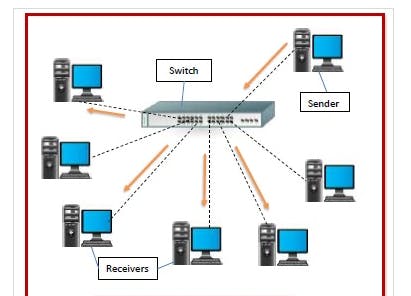
ROUTERS
Routers connect multiple networks together. Assume there are two networks with multiple devices connected: Network A & Network B,
Network A needs to send something to Network B, The 2 different networks need some kind of communication between each other, this is possible with routers. You all might have seen wifi routers in your home.
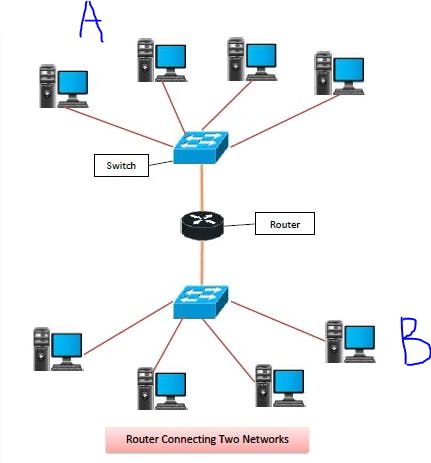
Access Points
Ever wondered how you get wireless wifi connections when in offices, malls etc. Through Access Points! An Access point is a device that creates a wireless local area network, or WLAN, usually in an office or large buildings like malls, cinema halls etc. An access point connects to a wired router, switch, or hub via an Ethernet cable, and projects a Wi-Fi signal to a designated area.
Ethernet cables are used to provide an internet connection, connect devices to a local network.
FIREWALL
In network security, a firewall is software or hardware that monitors incoming and outgoing traffic, based on predefined rules, and accepts, rejects, or drops the traffic accordingly. A firewall establishes a barrier between secured internal networks and outside vulnerable networks, such as the Internet.
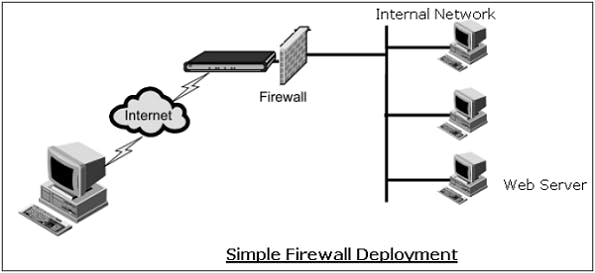
HUB
Hub is a device that acts as a central connection for devices in a network. Hub has ports on which the device is connected. Data arrives at the port from the sender and is sent to every other port where receiver devices can access it.
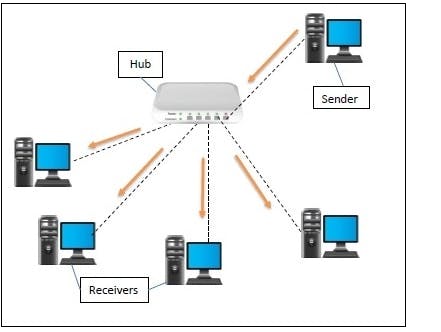
BRIDGES
A Bridge is a network device that connects multiple LANs with the same protocols together to form a larger LAN. For e.g. suppose there are 2 companies being run in a different building and work on different LAN networks but have some third party dependencies on each other. So they need to connect with the device present in the other LAN, this is possible with the use of bridges. It enables the different components to appear as if they are part of a single network.
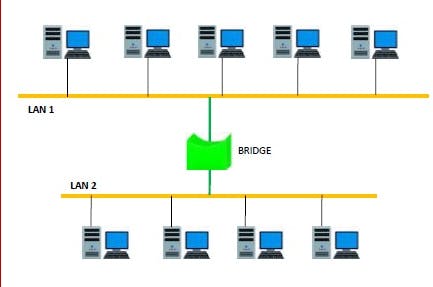
GATEWAY
Gateway is a network node that connects two networks using different protocols together. As by the name, we can say that it is a gate between two networks. A switch can be a gateway, a router can be a gateway, any device that enables the flow of traffic in & out of the network acts as a gateway. Gateways serve as an exit and entry point for a network as all data should go through or communication gateway before being routed.
So a question may arise in your mind that's what a router does, connects two networks. Right! the major difference between a router and a gateway is that a gateway can connect networks that are using different protocols . The Primary Goal of Gateway is to translate with one protocol then onto the next, while the Router is to Route traffic starting with one network then onto the next.
All these network devices work in specific layers of Networking models and follow protocols
So now we will be discussing What is Protocol & Networking models?
OSI ,TCP/IP Model & PROTOCOLS
PROTOCOL
Protocols are a set of rules. In networking, Network Protocols are a set of rules governing the exchange of information in an easy, reliable and secure way.
An example of the most common network protocol everyone uses is HTTP, HTTPS protocols while searching the web.
Understanding of Networking models like Open Systems Interconnection (OSI) model and the TCP/IP Model. and how they use different protocols is required
OSI model defines how applications communicate over a network with 7 layers defined in the model.
Check out this amazing diagram to understand OSI :
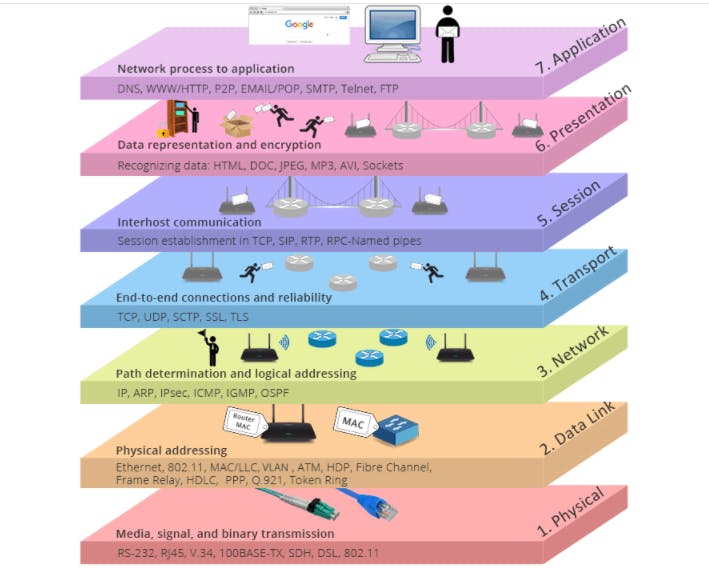
The TCP/IP model is a concise version of the OSI model. It contains 5 layers, unlike seven layers in the OSI model.
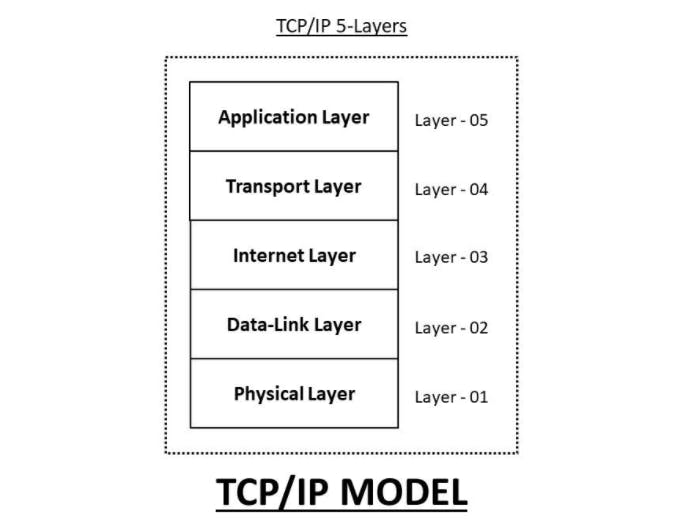
The simplest explanation I found out on Github for the difference between the two models. The internet is based on TCP/IP which is a "simplified" implementation of the theoretical OSI model. Maybe it's even better to say TCP/IP was inspired by the OSI model.
There are a number of protocols that govern activities at each level of a communication process.
Network layers beautifully explained here : plixer.com/blog/network-layers-explained
Resource to understand the 7 layers of OSI model : Here Here2
Resource to understand the TCP/IP model : Here
Types of Network protocols
There are mainly 3 types of protocols :
Network Communication protocol: HTTP (hyper text transfer protocol ), TCP (Transmission Control Protocol ), UDP (User Datagram Protocol )
Network Management protocol: Simple Network Management Protocol (SNMP) and Internet Control Message Protocol (ICMP).
Network security protocol: Secure Socket Layer (SSL), Secure File Transfer Protocol (SFTP) and Secure Hypertext Transfer Protocol (HTTPS).
Network Devices & Layers
Now you know what are the Network models, Layers and network devices . Look at this diagram and try to relate how network devices work in different networking layers.
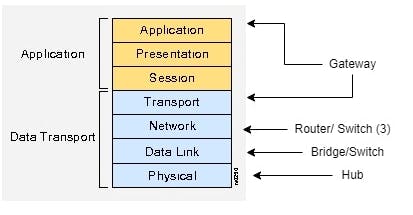
Switch (3) is a specific switch that works in layer 3 i.e. network layer. layer 3 switch combines the functionality of a switch and a router.
Gateway is mostly used in the Application layer but can be used in other layers from layer 4.
Conclusion
If you have reached here, you should be familiar with some basic networking terminology and be able to understand how different components and devices are able to communicate with each other.
In the next blogs, we will be continuing this networking learning & discussing some important concepts such as DNS, Subnetting, IP, Networking in Linux, Network Troubleshooting, Networking commands.
Stay Tuned & Keep Learning !
ABOUT THE SERIES
So, This was the explanation of Networking Basics from the Series "The Ultimate Guide to DevOps & Cloud".
If you want to Get started with DevOps make sure to check out our course on Twitter The Ultimate Guide to DevOps & Cloud
Master DevOps with our online community and join us in the initiative of learning DevOps & Cloud.
Follow the creators:
If you feel we should change any of our approaches in order to make this course the Best course, please comment down with your ideas. we would love to hear that from you.
And if you feel that this energy & effort, we are putting down in this is worth every penny then please share out with other folks who are struggling to break down into Tech-verse. Best of luck with a new journey & Happy Learning From the Team :)